A crescent moon hangs in the predawn sky as I carry the bag of electronics - SPOTS, gps's and epirb's - down to Spartina. Temperatures in the mid-40's and a strong north wind, Bruce and I had both dressed in our foul weather gear in the room at the Waterside Inn. I tuck the gear away and crank up the outboard.
One more load of gear - our duffles with sleeping bags, hypothermia kits and clothes - and we cast off, motoring the narrow path out of the marina through the stakes marking the shoals. Mizzen up first, then jib, then turning downwind to ride the outgoing current towards the inlet. Fighting the tiller I realize there was no need for the mizzen. Bruce takes the tiller while I lower the small sail and tie it to the mizzen boom. Not yet dawn and we are making 4.7 kts under jib alone.
The sun creeps up as we reach the south end of Chincoteague, the water rough as the ebb tide flows to the east under the strong north wind. Our plan had been to sail outside the inlet around the small bit of land called Chincoteague Point, coming back in on the far side of the inlet. The tide, rushing faster than expected, convinces us to take the shallow route behind Chincoteague Point.
We had been warned the day before that the channel behind the point had shoaled and by 6:30 we are both out of the boat walking Spartina across the sand flats. With the jib still raised, Bruce and I all slide the hull over the hard sand bottom for about 30 yards. Spartina skips across the sand and begins to float, Bruce jumps in and I'm right behind him as Spartina heads south towards Wallops Island.
Spartina sails southwest out of the narrows area, the ebb tide flowing from the south building a chop against the north wind. At marker "5" the water narrows between marshes and the island, the water calms. There is a light overcast, both the water and sky are grey, the marshes brown. To the south we can see the launch pads and radar dishes at a NASA site on Wallops Island.
At 7:15 Spartina sails into Island Hole Narrows, the first of several narrow, winding channels for the day. Skies clear and it warms up. I see a bridge to the south that we will need to pass beneath but the channel carries us to the southwest towards the island. Glancing at the chart and gps I convince myself I had taken a wrong turn and wonder how we will turn back up north into the strong wind. I call up to Bruce. He checks his gps and tells me we took the correct channel.
The marshes, brown near the inlet, are rich green in the shallows. The water is glassy calm but the wind still blows over 20 mph. We follow the narrow path at almost four knots, standing on the decks to see if we can recognize the waterway ahead. There are fewer markers than I would like, just green marker "17" rising out of the grass to mark the channel leading under the bridge. And even as we pass that marker we cannot see the waterway, only marsh. Finally the channel curves to starboard to reveal Cat Creek and the passage beneath the bridge.
South of the bridge we wind past a series of much welcomed markers towards Assawoman Bay. Narrow guts branch off port and starboard along the way, sand shoals and oyster reefs reach out from shore. It is beautiful, relaxing sailing. We track our position on the gps, recognizing along the way that the charts are not completely accurate. The gps shows a turn south up ahead at marker "26" but I see only small markers for a private channel. Glancing to port I see a deep, unmarked channel across the marsh. With a push of the tiller Spartina swings back and makes the cut through the grass into the channel.
At 8:30 we enter a long straight channel, Northam Narrows, just inside of Assawoman Island. We watch as a bald eagle hovers, then lands in the marsh. We sail south down the channel at over four knots.
Leaving the narrows we cross Kegotank Bay, turning southwest towards Gargathy Inlet. The channel will carry us just inside the inlet and we can already hear surf pounding the barrier island. A white mist, a combination of spray from the surf and windswept sand from the dunes, hovers over the inlet.
Approaching the inlet I'm surprised at how close we will come to the ocean waters. Waves break over the shallows, rolling into the channel. It is a spectacular sight with sand dunes north and south, shoals and surging water.

The wind and the running tide carry us down the channel. We cling to the marshy shoreline where the water looks deeper. Bruce calls back that we are making eight knots, four of the knots coming from the rushing tide. Midway through the inlet we meet the tide rushing from the south and our speed drops to one knot. We seem to inch along as the jib pulls us through the inlet. Suddenly an eddy catches Spartina and turns her toward the ocean. I push the tiller to port, the boat hesitates, swings back south. I am grateful for the strong wind.
Gradually our speed increases as we move south out of the inlet. A knot, then two, then back to almost four knots as we leave the rushing tide behind.
It is not yet 10 a.m. and we've covered much more distance than expected. I tell Bruce that Gargathy Inlet was the biggest challenge, it will be easy sailing from here on out. It is a serpentine ride through the marsh grass as the waterway curves port and starboard, the channel hidden is the rich brown savanna.
We break out some snacks - beef jerky and crackers - and enjoy the sail south. Following Crippen Creek we count off markers "65", ""66" and "67". At marker "68" I look across the marsh with binoculars for "70" and ""71" which will lead us to a shallow area behind Metomkin Island and then on a channel that will carry us south.
I see only one post, that one with a danger sign. Bruce looks at his chart and gps, sees the markers there but he cannot find them on the horizon. He says the danger sign is about where "70" should be.
We follow the creek as it turns southwest, looking for the opening to the south. Passing by the danger sign I scan the water for an oyster reef or a sunken boat, trying to understand the need for the warning sign.
The creek runs along the marsh and we watch for the shallow cut. The creek ends abruptly at a sandy beach. I turn Spartina into the wind, run up on the beach and Bruce sets out the anchor.
We look at the charts, look at the sand, realizing that Metomkin Island has been pushed back into our channel south. There is a narrow gut between the sand and the marsh, bone dry. A local fisherman walks over from the beach. I ask about the channel south. He tells me that at high tide only the smallest boat can make it through the channel. Looking at Spartina he says we won't make it through.
I ask about any other way south. He mentions some guts back up Crippen Creek, though they are probably too small for Spartina. Maybe Gargathy Bay, he says.
The wind, if anything, is picking up. We drop the jib, put up the mizzen as a steadying sail and motor back towards Gargathy Inlet. In the wind and chop we can make just a little over a knot. We pass two cuts into the marsh, neither wide enough for Spartina. We continue on, passing two larger passages that are shoaled. At Gargathy Creek we turn west, sail by a couple fishing boats and ask about a passage south to Wachapreague. People shake their heads, shrug their shoulders. Nobody knows of a way south.
We sail into Gargathy Bay, shallow at best and very shallow at low tide. I bring the board and cb up, the strong afternoon winds, gusting over 30 miles an hour, push us across the bay onto a mud flat. I try to step out of Spartina to push us off, my foot sinks into the mud. We drift until we drift no more. Sitting on the mud flat I toss out the anchor. Stranded, we get out the charts and look at our gps's in search of a way south. We see only two, the sand-blocked channel on Crippen Creek and then a tiny winding gut through the marsh which is marked as only by a thin blue line, questionable at best for a boat Spartina's size.
Tired and frustrated I fall asleep while waiting for the incoming tide, wondering if Spartina will become one of those derelict boats in the marshes that make for all those wonderful Chesapeake Bay paintings.
Tired and frustrated I fall asleep while waiting for the incoming tide, wondering if Spartina will become one of those derelict boats in the marshes that make for all those wonderful Chesapeake Bay paintings.
Bruce wakes me an hour and a half later. Spartina is floating in shallow water, but in the high wind she is dragging anchor across the mudflats towards shallower water. We raise the jib and sail off the flats into deep enough water to put down some cb and rudder. I start the outboard, the prop quickly getting tangled in seaweed. Bruce sets out the anchor while I clean the prop. We motor, get tangled again, set out the anchor, clean the prop. And then we do that two more times until Spartina is clear of the grass.
We motor to a boat ramp about a mile away. With no clear passage to the south, too strong of wind to make it back to Chincoteague, a forecast for three more days of wind plus rain and fog, we decide that the trip was over. Completing the Delmarva circumnavigation will have to wait for another day.
steve
--------------------------------------------------------
The frustration set in the following morning. We had driven to Cape Charles on our way home. Standing near the gazebo on the beach I looked out past the shallows to the water we should have been sailing on in a couple of days. It was foggy, cold and breezy, but the water was calm in the lee of the Eastern Shore. I wished we were out there.
It was the wind that did us in. Instead of dropping to 15-20 with gusts to 25 as forecast, the wind stayed at 23 mph with gusts to 33. The strong wind combined with shallow, narrow waterways means no maneuverability for a yawl. Downwind is the only way to go.
I sometimes think about the passage at Crippen Creek and wonder if we could have made it at high tide. I also wonder if we could have tried to make it and found ourselves stranded halfway through the narrow channel, trapped between the sand and the marsh with a falling tide.
We have since talked to a few people about the passage south inside the barrier island. Some people say it can be done, other say it can't. Looking at the satellite photos it is clear that Metomkin Island has been pushed to west, possibly by Hurricane Irene or Hurricane Sandy, maybe by both. It reminds me of the new inlets forming on Hatteras Island, the storm surge battering the island and pushing the sand back to create an opening in the island.
Sailing offshore from Chincoteague Inlet to Wachapreague, then south inside the barrier islands now seems to be the way, maybe the only way, to complete the circumnavigation. And possibly a fall trip when the ocean waters are warmer and north winds are more consistent. We'll have to think about that. And if we plan an offshore trip we'll be sure to have an alternate plan - i.e. a week long sail on the bay - ready to go if the weather is not right for going outside the barrier islands.
So the spring cruise was just a one day sail, not quite 23 miles. But I will say it was one of the most exciting, beautiful days Spartina has had on the water. It was not the cruise we had planned, but at the same time there are no complaints here.
We have since talked to a few people about the passage south inside the barrier island. Some people say it can be done, other say it can't. Looking at the satellite photos it is clear that Metomkin Island has been pushed to west, possibly by Hurricane Irene or Hurricane Sandy, maybe by both. It reminds me of the new inlets forming on Hatteras Island, the storm surge battering the island and pushing the sand back to create an opening in the island.
Sailing offshore from Chincoteague Inlet to Wachapreague, then south inside the barrier islands now seems to be the way, maybe the only way, to complete the circumnavigation. And possibly a fall trip when the ocean waters are warmer and north winds are more consistent. We'll have to think about that. And if we plan an offshore trip we'll be sure to have an alternate plan - i.e. a week long sail on the bay - ready to go if the weather is not right for going outside the barrier islands.
So the spring cruise was just a one day sail, not quite 23 miles. But I will say it was one of the most exciting, beautiful days Spartina has had on the water. It was not the cruise we had planned, but at the same time there are no complaints here.























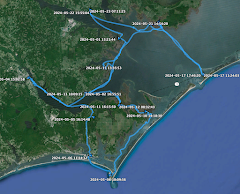
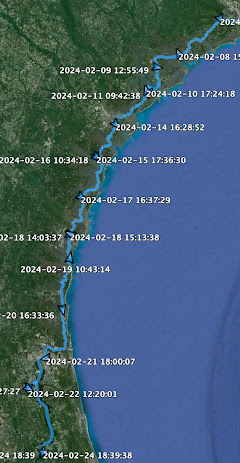

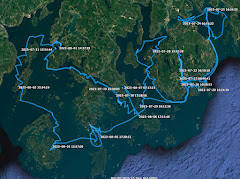

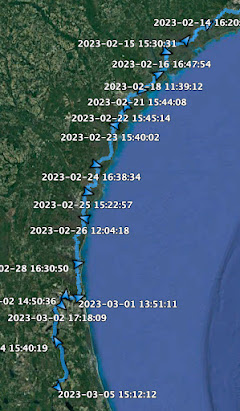


























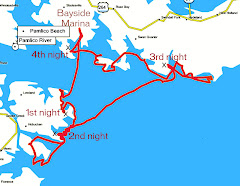


1 comment:
I am glad you were safe and look forward to reading your log entry after one day catching a fair wind offshore and finishing the circumnavigation.
Post a Comment